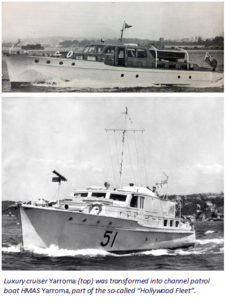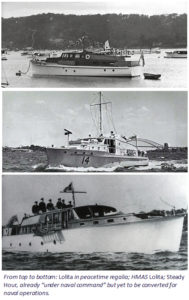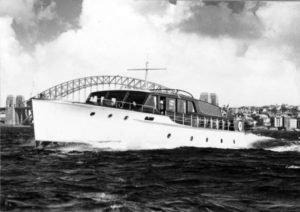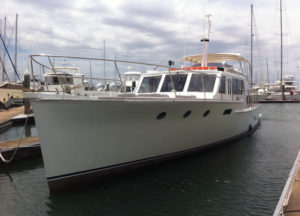How four luxurious gin palaces became hard-working heroines of the Battle of Sydney Harbour.
By Neale Philip
The following story was first published in the Australian National Maritime Museum (ANMM) Volunteers’ Quarterly newsletter ‘All Hands’, Issue 114 in March 2021.
Many fleets have graced Sydney Harbour in the nearly 250 years of white settlement. Noted ones include the First Fleet in 1788, the Great White Fleet in 1908, the RAN and International Fleets in the RAN Centennial Review of 2013, and let’s not forget the yachting fleets of many classes that regularly race on the harbour. The Hollywood Fleet of World War II was another proposition altogether.
Prior to WWII, the Halvorsen company and other Sydney boat builders had been building pleasure cruisers of various sizes. Wealthy clients were ordering luxurious high-end vessels, of 45 feet and longer, with twin engines, and fitted out with as many as eight berths, including an owner’s cabin, toilets, comfortable saloons and extensive galleys. These vessels participated in regular regattas and hosted VIP guests.
But the Navy was seeking vessels for many duties during the war, and the country’s wartime requisitioning powers were enacted, to repurpose 13 of these luxury cruisers into channel patrol boats. Exterior trims of white hulls and varnished superstructure gave way to Navy colours. Deck trimmings now would include .303 machine guns fore and aft, and two depth charge racks on the stern. Some were fitted with ASDIC anti-submarine detection equipment. The vessels gained the collective nickname “the Hollywood Fleet”.
Twelve of the fleet were in Sydney Harbour of the night of 31 May and the early hours of 1 June 1942, when three Japanese midget submarines entered the harbour to attack Allied naval shipping. Four of them, the auxiliary patrol vessels (ex-luxury cruisers) HMA Ships Yarroma, Lolita, Steady Hour and Seamist, played active roles in the events of that night, launching attacks on the submarines. Their stories in brief follow.
Yarroma
Yarroma was built by W. L. Holmes and launched in late 1939. She was 58½ feet long. Her accommodation included a two-berth cabin, a single-berth cabin, a crew’s cabin, galley with gas stove and electric refrigerator, shower room, toilet, dining saloon and a deck saloon.
 On the night of 31 May 1942, HMAS Yarroma was stationed with HMAS Lolita at the not-yet-completed harbour boom net that stretched roughly between Watsons Bay and Chowder Bay. She was the Navy vessel that received the first verbal report from a civilian that “a submarine or a mine” had been sighted at the western end of the net. She was ordered to investigate further, and signalled to HMAS Lolita at the other end of the net to come across. Meanwhile, a sailor from HMAS Yarroma positively identified the object as a submarine caught in the boom net, but it was HMAS Lolitathat launched an attack (Lolita’s story follows).
On the night of 31 May 1942, HMAS Yarroma was stationed with HMAS Lolita at the not-yet-completed harbour boom net that stretched roughly between Watsons Bay and Chowder Bay. She was the Navy vessel that received the first verbal report from a civilian that “a submarine or a mine” had been sighted at the western end of the net. She was ordered to investigate further, and signalled to HMAS Lolita at the other end of the net to come across. Meanwhile, a sailor from HMAS Yarroma positively identified the object as a submarine caught in the boom net, but it was HMAS Lolitathat launched an attack (Lolita’s story follows).
In the early morning hours of 1 June, after another of the midget submarines had fired its two torpedoes, and full alerts had been issued to all ships in the harbour, HMAS Yarroma was called to Taylors Bay to use its submarine detection gear to locate a third reported submarine. A contact was made, and she dropped a depth charge in the relatively shallow water, the shock wave of which lifted her engines off their mounts and disabled her. Her role in the battle earned her the Pacific 1942 battle honour.
Records suggest that HMAS Yarroma remained based in Sydney Harbour after the battle, and in late 1945 she was sold at auction. Nothing more is known of her.
Lolita
Lolita, a 54-foot bridge deck cruiser (pictured on the next page), was also built in Holmes’ Sydney boatyard, and was launched in late 1936. Her galley was fitted out with a gas stove and full-size oven, and refrigeration. The dining saloon contained built-in furniture consisting of a sideboard, desk, wireless cabinet, and lockers. A fireplace had a bas-relief carved mantel of the Endeavour sailing for Australia, and contained an electric radiator.
The bridge deck had polished maple woodwork and chrome fittings. Two upholstered seats extended to provide full-size berths. The bathroom below contained a bath and basin, plumbed with hot and cold fresh and salt water. The owner’s cabin was described as occupying the full width of the vessel, and was fitted with two double berths, locker space, and two built-in wardrobes and a dressing table.
On the night of 31 May 1942, HMAS Lolita was also stationed at the harbour boom net. Having been called over to the other end of the boom net by HMAS Yarroma, HMAS Lolita confirmed the presence of the submarine caught in the net and launched two depth charge attacks. Neither charge exploded, as the pre-set depth of the charges was greater than the water depth. Before a third attack could be mounted, it was apparent that the submarine had spied HMAS Lolita, and its own self-destruct charge was set off. The explosion in the submarine was reported, and HMAS Lolitaresumed her patrol duties.
 Post Sydney Harbour, HMAS Lolita was deployed to Newcastle, and subsequently to north Queensland, and lastly to Papua New Guinea. Her ultimate fate was to be destroyed by fire in Alexishaven near Madang in June 1945.
Post Sydney Harbour, HMAS Lolita was deployed to Newcastle, and subsequently to north Queensland, and lastly to Papua New Guinea. Her ultimate fate was to be destroyed by fire in Alexishaven near Madang in June 1945.
Steady Hour
Steady Hour II was built in 1940 in Halvorsen’s Neutral Bay yard, and measured 56 feet in length. Her superstructure and interior woodwork were of Queensland maple, and she accommodated eight people in four cabins, with two bathrooms and an extensive galley.
In the early hours of 1 June 1942, and after the general enemy submarine alert had been issued, HMAS Steady Hour left her off-duty anchorage in Farm Cove to patrol the harbour between Bradleys Head and the boom net along with HMAS Seamist(see Seamist’s story later). After one of the midget submarines was sighted in Taylors Bay, and anti-submarine detection gear on HMAS Yarroma confirmed a contact, HMAS Steady Hour made a number of depth charge runs against the target. The submarine was destroyed in the bay by the multiple attacks of the participating vessels. HMAS Steady Hour’s role in the battle earned her the Pacific 1942 battle honour.
She relocated to Port Kembla in late 1943, and was despatched to Darwin in 1944. Returning south for refit in early 1945, she was destroyed by fire while refuelling en route.
Seamist
 Seamist was launched from Halvorsen’s Neutral Bay yard in 1939. At 60 feet in length, her fit-out included four bedrooms with accommodation for eight people, dining room, bathroom, galley and wheelhouse.
Seamist was launched from Halvorsen’s Neutral Bay yard in 1939. At 60 feet in length, her fit-out included four bedrooms with accommodation for eight people, dining room, bathroom, galley and wheelhouse.
In the early hours of 1 June 1942, HMAS Seamist launched the initial depth charge attacks on the midget submarine spotted in Taylors Bay. The force of the exploding second depth charge dislodged one of her engines and she was forced to withdraw. For her role in the battle, HMAS Seamist was awarded the Pacific 1942 battle honour.Glamourpuss
Seamist on Sydney Harbour in 1939
She then spent time patrolling at Port Kembla and Sydney. She accompanied HMAS Steady Hour to Darwin in 1944 and on their return journey for refit in 1945, during which HMAS Steady Hour was lost, HMAS Seamist eventually reached Sydney, and was repurchased by her original owner when disposed of in late 1945.
 During her post-war years, Seamisthad a succession of owners. A well-known owner in 1954 was radio personality of the time, Jack Davey. Davey had her lavishly reappointed and included a piano and cocktail bar. He entertained many international and local celebrities on board, as well as many people associated with the charities he supported. Last sold in 1982, her current owner was reportedly able to locate Davey’s piano, and it is now back on board.
During her post-war years, Seamisthad a succession of owners. A well-known owner in 1954 was radio personality of the time, Jack Davey. Davey had her lavishly reappointed and included a piano and cocktail bar. He entertained many international and local celebrities on board, as well as many people associated with the charities he supported. Last sold in 1982, her current owner was reportedly able to locate Davey’s piano, and it is now back on board.
The story of the 1942 midget submarine attack on Sydney Harbour has been told in many publications over the years, starting with official reports during the war. Some of these reports have subsequently been found to be incomplete. But the harbour patrol vessels that featured in the defensive battle had their own stories, of their origins and of their wartime roles and beyond. The memory of the Hollywood Fleet lives on.
Author’s note:
Permission of the author of the comprehensive and extensively researched primary source below to use material from it for this article is gratefully acknowledged.
Primary source:
Blunt, W., 2020, Lolita and the Hollywood Fleet, www.lolitaandthehollywoodfleet.com
Secondary source:
www.navy.gov.au/history/feature-histories/japanese-midget-submarine-attack-sydney-harbour




